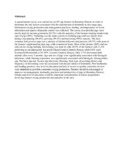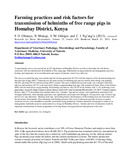| dc.description.abstract | A questionnaire survey was carried out on 297 pig farmers in Homabay District in order to determine the risk factors associated with the transmission of helminths in free range pigs. Information on pig production and management practices, feeding, and importance of worm infestation and aspects of parasite control was collected. The survey revealed that pigs were mostly kept for income generation (83.2%) with the majority of the farmers keeping nondescript type of pigs (98%). Tethering was the main system of confining pigs and was mostly done during crop planting (98.6%), growing (99.3%) and harvesting (99%) seasons. The most common feed given to pigs was a mixture of kitchen
leftovers and pastures (40.7%) with none of the farmers supplementing their pigs with commercial feeds. Most of the farmers (80%) did not seek advice on pig farming. Deworming was done by only 20.5% of the farmers with 11.4% preferring to use
piperazine( Ascarex®,30gm,Cosmos Limited, Kenya) while 8.8% used levamisole(Wormicid®,1.5% W/V, Cosmos Limited, Kenya). Only 3.7% dewormed their animals after every 3 months. Age and sex of pigs were significantly associated with Strongyle infections, while farming experience was significantly associated with Strongyle, Strongyloides spp, Trichuris spp and Ascaris spp infections. Housing, feed-type, deworming history and frequency of deworming were not associated with
the prevalence of helminths. Poor husbandry and feeding practices, low level of education and lack of access to quality extension services were identified as possible constraints on pig production. Farmers should be encouraged to improve on management, husbandry practices and productivity of pigs in Homabay District. Gender and level of education would be important considerations in future programmes involving farmers on pig production and parasites in the area. | en |


